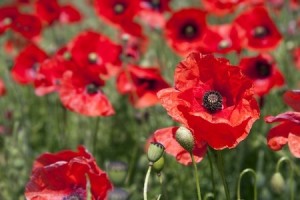Legacy of the “Joy Plant”

There is a new, allegedly less addictive painkiller in the pharmaceutical pipeline, CR845, by Cara Therapeutics. Although CR845 is being touted as “non-addictive” (here and here); or a “non-absusable alternative to narcotic opioids” by Cara Therapeutics, that remains to be seen. CR845 is anticipated to be a Schedule 5 controlled substance. This is significantly less addictive than OxyContin and other opioid pain relievers, which are mostly Schedule 2. Even a less addictive pain medication would be great. But the history of opiates is full of similar promises.
The earliest reference to opium was in 3,400 BC where the Sumerians in lower Mesopotamia referred to it as Hul Gil, the “joy plant.” They, in turn, passed the knowledge of the opium poppy to the Assyrians, who gave it to the Babylonians, who passed it on to the Egyptians. The Egyptians were famous for their poppy fields and the opium trade flourished during the eighteenth dynasty (around 1500 to 1300 BC) under the reigns of Thutmose IV, Akhenaton and King Tutankhamen. Roman gladiators used opium to enhance their fighting … and to die as painlessly as possible if mortally wounded.
Hippocrates, the father of medicine, saw opium as a helpful narcotic for treating disease. The great physician Galen, cautioned that opium should be used sparingly in 158 AD. He said it was better to endure pain than to be bound to the drug. It wasn’t until 400 AD that opium was introduced into China by Arab traders.
A History Channel documentary reported that Alexander the Great used opium to help his soldiers march farther because they couldn’t feel the pain in their feet; and they could sleep through the night because the wounded were sleeping peacefully under the influence of opium. He introduced opium to India, where it’s cultivation flourished. One of the goals of Columbus was to bring back opium from India, as its access had been cut off when the Arabs were expelled from Spain. He didn’t get to India, but he brought back tobacco from the New World and smoking tobacco became common throughout Europe.
Portuguese traders began smoking a tincture of opium with their tobacco around 1500. They also discovered the euphoric effect was instantaneous. In 1680, the English apothecary Thomas Sydenham introduced laudanum, a compound of opium, sherry wine and herbs. Dutch traders introduced the practice of smoking opium to the Chinese around 1700. The Chinese loved the habit and it led to cultural and political ruin. By 1800, 1/3 of the country was addicted to opium.
In 1803, a German chemist named Friedrich Sertuerner synthesized morphine from opium. Sertuerner’s wife overdosed on morphine and died. He then publically warned against its dangers. But morphine was also a great step forward in medicine. It allowed doctors to do true surgery for the first time. Morphine was heralded as “God’s own medicine” for its reliability and long-lasting effects. By 1827, the E. Merck & Company of Darmstadt Germany was commercially manufacturing morphine.
A new technique for administering morphine was developed by Dr. Alexander Wood of Edinburg when he invented the syringe in 1843. Wood believed that if morphine was injected instead of swallowed, “patients would not hunger for it.” He was wrong; and several of his patients became dependent. There is a mythical story that Wood’s wife was among the earliest of these addicts, and died of a morphine overdose. But according to Richard Davenport-Hines, she outlived her husband and survived until 1894.
Needles and morphine were quickly in demand. You could order morphine, opium and syringes through the mail … from Sears and Roebucks. They became a blessing during the Civil War on the battlefield. But their use created a generation of young ex-soldiers as morphine addicts. Morphine addiction became known as “the soldier’s disease” or “the army’s disease.” This was the first drug epidemic in the United States. Nineteenth century America became “a dope fiend’s paradise.”
Morphine even became part of medical missionary efforts in China. They were selling opium pills and morphine powders, which became known as “Jesus opium.” The Chinese Recorder and Missionary Journal, Vol. 19, published in 1888, had a letter from a concerned person in Foochow: “Missionaries who dabble in this kind of business, probably most of them innocently, should know that their supposed help to suffering humanity is in the majority of the cases an injury to the patient and a positive evil in the church.”
Dr. John Witherspoon warned his fellow doctors in a June 23, 1900 article about their indiscriminant use of morphine. The morphine habit was growing at an alarming rate; and doctors were culpable for “too often giving this seductive siren until the will-power is gone.” Pointing to the Great First Physician, he said doctors should “save our people from the clutches of this hydra-headed monster” which wrecked lives and filled jails and lunatic asylums.
Looking for a non-addictive derivative of opium that could be used as a cough suppressant, the Bayer chemist Felix Hoffman successfully synthesized diacetylmorphine—heroin. When a Bayer executive introduced the drug to the Congress of German Naturalists and Physicians, he said it was 10 times more effective as a cough suppressant than codeine; it was more effective than morphine as a pain reliever and not habit-forming. Bayer began to sell it commercially in 1898 and by 1899 was producing about 1 ton of heroin yearly. The Boston Medical and Surgical Journal said heroin had many advantages over morphine, including: “It’s not hypnotic, and there’s no danger of acquiring a habit.”
Reports of “heroinism” had already surfaced, by 1900, but it took time for the sale and endorsements of heroin to stop. In 1906, the American Medical Association approved heroin for medical use, while cautioning that a “habit” was “readily formed.” In 1913, Bayer stopped making heroin. In 1919 it became illegal for doctors to prescribe heroin to addicts. In 1924, the US banned the use and manufacture of heroin altogether.
